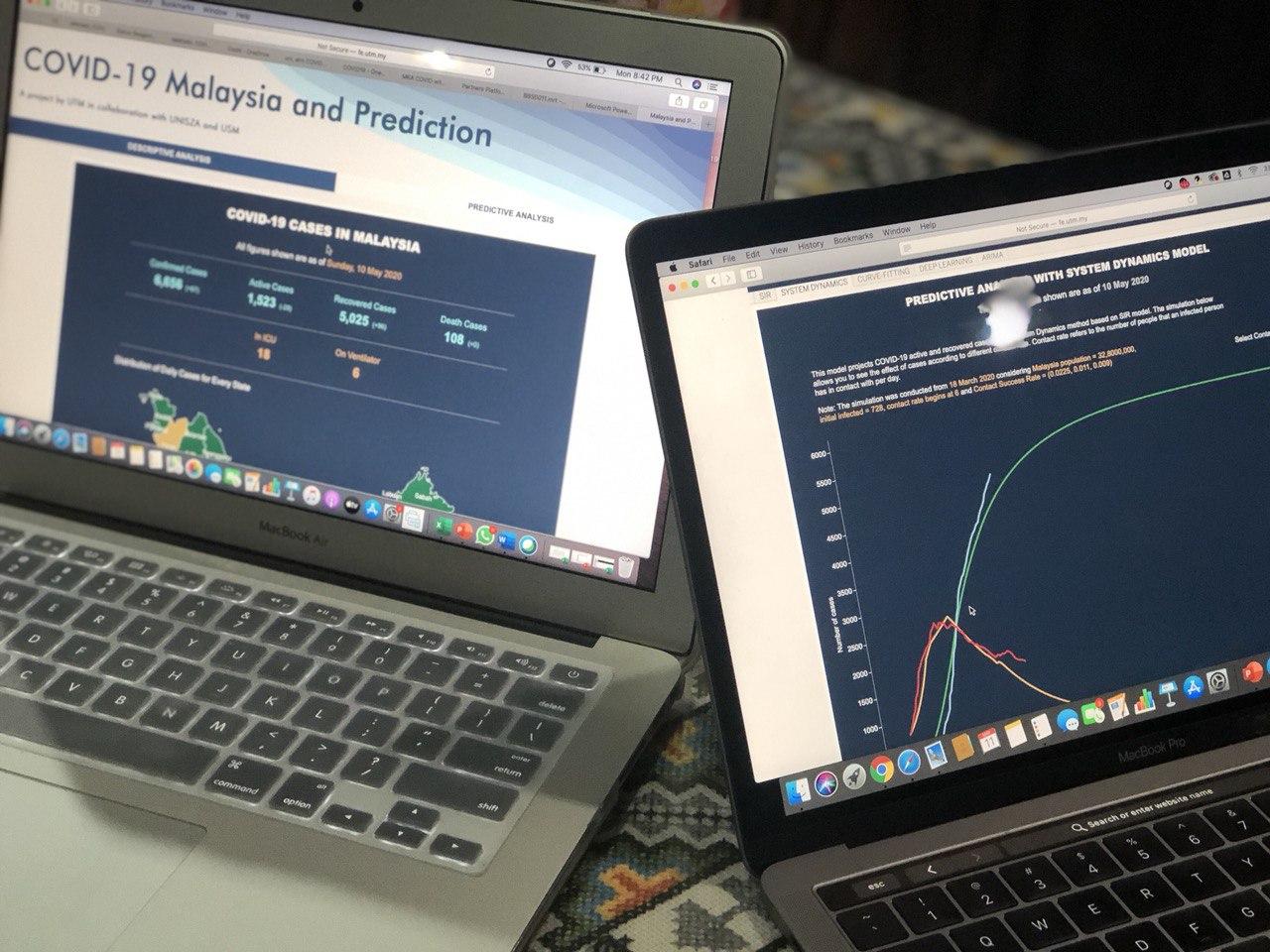By: Assoc. Prof. Dr Masitah Ghazali and Dr. Sharin Hazlin Huspi
On 11th March 2020, WHO declared COVID-19 a global pandemic. Malaysia saw its first few cases as early as January, but not until 18th of March, the Movement Control Order, or better known as MCO, was imposed. The atmosphere at that time was mixed. Some were worried, anxious, and some were even sceptical. Malaysians have now been under MCO for nearly two months.
Despite the daily information of the current situation being announced by the Director-General of Health, neither of us know what to expect, or how the situations will be in the next few days to come. These questions reflect the concerns and worries of Malaysians.
Today’s technology enables us to do wonders, which includes predictions. To give insights about the current situation in Malaysia, the Faculty of Engineering UTM has collaborated with UNISZA and USM to develop an interactive website that houses descriptive and predictive dashboard in order to learn about the COVID-19 outbreak trends in Malaysia.
The project, which is led by Prof Dr Naomie Salim, gives insights on Malaysia’s COVID-19 current scenario as well as the possibility of COVID-19 infections in the near future.
The team members are Prof. Ir. Dr. Shuhaimi Mansor, Dr. Nor Erne Nazira Bazin, Dr. Chan Weng Howe, Assoc. Prof. Dr. Anazida Zainal, Fadilah Ariffin, Dr. Sharin Hazlin Huspi, Eric Khoo Jiun Hooi, Dr. Hamza Hentabil, Assoc. Prof. Ir. Dr. Mohd Athif Mohd Faudzi, Assoc. Prof. Ts. Dr. Masitah Ghazali, and Looi Kian Seng from Universiti Teknologi Malaysia (UTM), and a group of epidemiology experts and bio-statisticians from UNISZA; Prof. Dr. Abdul Rahim Wong, Prof. Dr. Nyi Nyi Naing @ Syed Hatim Noor and Dr. Safiya Amaran, and from USM; Assoc. Prof. Dr. Kamarul Imran Musa and Dr. Wan Nor Arifin.
The dashboard incorporates five models under the predictive dashboard tab, namely SIR, Systems Dynamics, Curve Fitting, Deep Learning and ARIMA. Each model predicts the number of active cases over a period of time; thus, it is able to forecast when the COVID-19 outbreaks will subside. The models also provide understanding on how the virus spreads and if the government’s MCO really works. Each model uses different parameters to predict the outbreak.
The SIR model is used to compute the theoretical number of people infected with the contagious disease over time. With this model, viewers are able to predict the number of susceptible people (S), infected people (I) and those who recovered and died (R) via several coupled equations.
Systems Dynamics model projects COVID-19 active and recovered cases using System Dynamics method based on SIR model. In the dashboard, the System Dynamics model allows the viewers to see the effect of cases according to different contact rate (contact rate refers to the number of people that an infected person has in contact with, per day).
The third model, Curve Fitting, predicts COVID-19 active cases using exponential power of statistical method (Probability Density Function). This method provides number of active people infected daily, rate of infected, peak value and end of COVID-19. The exponential power is a function of sigma (one over six of recovery period) which is also known as standard deviation. The range of sigma was estimated from recovery period of COVID-19 in China and South Korea.
The dashboard also includes a machine learning based model, Deep Learning and a statistical model, ARIMA. The Deep Learning uses the Multivariate Convolutional Long Short-Term Memory to project COVID-19 active and recovered cases in Malaysia. The model was trained on the number of active and recovered cases of COVID-19 cases in countries around the world, together with the dates of restriction and quarantined declared by each affected country.
The ARIMA model is able to predict the trend of any time series by separating the signal (up or down trend) from the noise, and is further extrapolated to obtain forecast values.
Our data crawler crawls several online news and related websites to gather relevant data for the project. This includes COVID-19 data on the number of susceptible, infectious, recovered, and deceased patients for world countries from Worldometer and Johns Hopkins University Center for Systems Science and Engineering, and also publicly available data from online news, e.g. The STAR and Malaysiakini, and also by the Ministry of Health Malaysia (MOH) and Majlis Keselamatan Negara (MKN) websites.
It is hoped that this effort by our team will benefit the society in one way or another.
This project is funded by UTM short-term UTM Shield COVID19 grant no R.J130000.7751.4J454 COVID19 Prescriptive Action and Prediction Tool and supported by Faculty of Engineering UTM.
For further enquiries regarding the project, please contact Prof Dr Naomie Salim (naomie@utm.my).
Want to know what Malaysia COVID19 scenario looks like and will possibly look like in the near future? Please visit: http://fe.utm.my/covid19/

